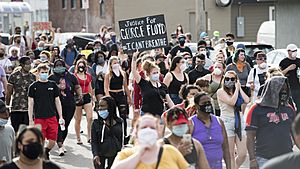George Floyd protests in Minneapolis–Saint Paul facts for kids
Quick facts for kids George Floyd protestsin Minneapolis–Saint Paul |
|
|---|---|
| Part of George Floyd protests | |
|
Clockwise from top
|
|
| Date | May 26, 2020 – ongoing (5 years, 7 months and 2 days) |
| Location | |
| Caused by |
|
| Goals |
|
| Methods | Mass demonstrations, civil disobedience, civil resistance, riots, arson, public art |
| Status | Prolonged local unrest |
| Aftermath | |
| Death(s) |
|
| Arrested | 604 from May 27, 2020—June 2, 2020 |
| Charged |
|
The George Floyd protests in Minneapolis–Saint Paul started on May 26, 2020. These protests began after the death of George Floyd. His death happened the day before, on May 25, 2020. A video showed a police officer, Derek Chauvin, kneeling on Floyd's neck. Floyd struggled to breathe and died.
This event caused strong reactions. People in Minneapolis and Saint Paul were very upset. The protests quickly grew into a worldwide movement. People protested against police brutality and racial inequality. For three nights, from May 27 to May 29, 2020, there was widespread unrest in the area.
Contents
Understanding the Protests
What Caused the Protests?
The main reason for the protests was the death of George Floyd. A video of his death spread widely. It showed a police officer kneeling on his neck. This video made many people angry. They felt it showed a serious problem with how some police treated people.
The protests were also about bigger issues. These included racial inequality and economic unfairness. Many people felt that these problems had been ignored for too long. They wanted change and justice for everyone.
What Happened During the Protests?
After George Floyd's death, many people gathered to protest. They marched and held demonstrations. Some of these events turned into civil disorder. This means there was public unrest and some damage.
In Minneapolis, many buildings were damaged. This happened mostly along a street called Lake Street. The city's third police station was taken over by protesters and set on fire. In total, about 1,300 properties in Minneapolis were damaged. Nearly 100 of these were completely destroyed.
Saint Paul also saw damage. About 330 buildings were affected there. Most of this damage was along University Avenue.
How Authorities Responded
The governor of Minnesota, Tim Walz, called in the Minnesota National Guard. These are soldiers who help in emergencies. About 7,123 troops were sent to help. This was the largest number of state forces used since World War II.
By early June 2020, the protests had caused a lot of damage. More than $500 million in damage occurred to about 1,500 properties. This made it one of the most damaging periods of unrest in U.S. history. Over 600 people were arrested during this time.
Most of the intense protests in Minneapolis–Saint Paul calmed down after May 30, 2020. The National Guard and other groups helping to manage the situation left by June 7, 2020. However, smaller protests continued into 2021 and 2022. These later protests also focused on other issues of racial injustice.






